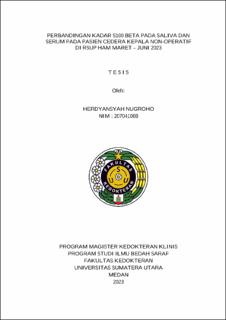| dc.description.abstract | Background : Traumatic brain injury (TBI) is prevalent, accounting for >3 million emergency cases yearly in the US. Primarily from traffic accidents and falls, its main complication, intracranial bleeding, escalates mortality risk. Detecting early blood-brain barrier disruptions using S100B serum protein shows promise, warranting research comparing serum and saliva S100B levels in non-operative TBI patients.
Aims: To determine the comparison of S100Beta levels in saliva and serum in non-operative head injury patients at HAM Hospital March - June 2023.
Methods: This research is an observational analytical study with a cross sectional design. This study examines the S100B levels in saliva and blood serum at the same time. The results of the S100B checks on these two variables will be compared and statistically analyzed. The S100B level checks were carried out on patients with non-operative head injuries by taking saliva and blood samples from patients at the same time and then sending them to a standard laboratory. The results of the S100B level checks will be compared between saliva and blood and their relationship with the patient's CT Scan results.
Results : The population of head injury patients at Haji Adam Malik Hospital Medan during the study period was 43, with 19 receiving surgery and 4 declining participation, leaving 20 respondents meeting the criteria to be research subjects - lower than the 161 minimum sample size stated in the methods. Mean S100B concentration was 28.526 ± 4.061 μg/L in serum and 47.531 ± 2.852 μg/L in saliva, with median levels of 23.265 μg/L and 46.31 μg/L respectively. Minimum and maximum concentrations ranged from 0.69-62.05 μg/L in serum and 13.4-63.98 μg/L in saliva. 4-parameter logistic (4PL) curve analysis yielded an R2 of 0.9966, indicating that 99.66% of the variance in non-operative traumatic brain injury intracranial hemorrhage can be explained by variance in S100B levels. In summary, a lower than intended subject number was included, higher S100B was found in saliva versus serum, and the 4PL model shows a strong correlation between S100B and intracranial hemorrhage in this population.
Conclusion : This preliminary study found higher S100B levels in saliva compared to serum among patients with non-operative traumatic brain injuries and suggests promising accuracy and utility of salivary S100B levels in the assessment of traumatic brain injury severity. | en_US |




